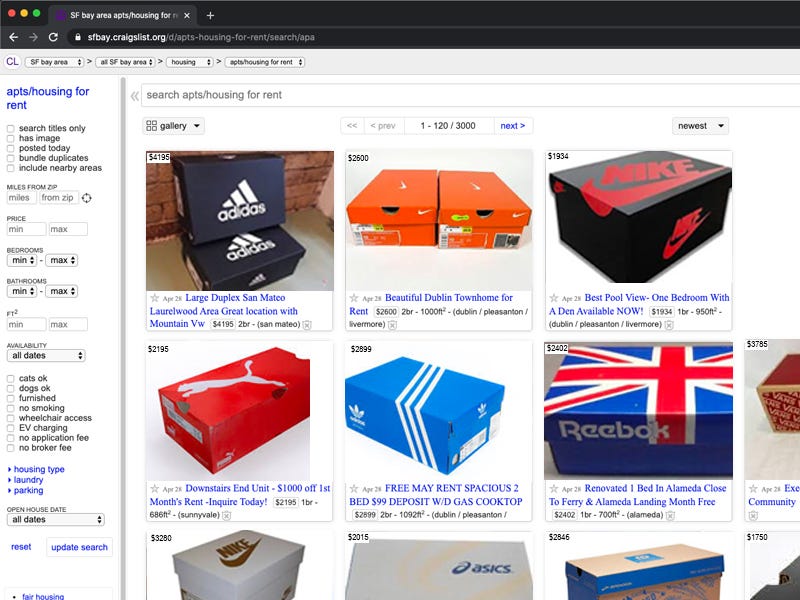Thanks for joining me for the 15th issue of the Golden Stats Warrior, a newsletter for data-based insights about the Bay Area. If this is your first time reading, welcome! If you haven’t signed up yet, you can do that here. I am so grateful for your support, and I hope you and your loved ones are holding up well. Also, this week we have a themed “illustration” from multitalented Jared Joiner.

When the shelter-in-place order for the Bay Area went into effect, I was living in a 350 square foot Oakland studio. I am a privileged person with a good job and no dependents, but still, at times, it was hard.
My situation was not unusual for a Bay Area resident. The region’s housing is cramped. (I used the past tense because, luckily, I was able to move into a slightly bigger one bedroom in my building a couple weeks ago.)
Data from the US Census’s American Housing Survey collected in 2017 show that among the US’s 15 biggest metropolitan areas San Francisco is tied with Los Angeles for having the housing with the least room per person. Of the approximately 1.7 million residences in the San Francisco-Oakland metro area, the average residence has 550 square feet per person (this includes houses and apartments). The average home in Atlanta has 800 square feet per person, nearly 50% more.

In some ways, the lack of space per person is not such a bad thing. The city is densely packed, which is better for the environment, and allows many people to be closer to their work. But during a global pandemic, it’s not so great. Typically people living in tight quarters can use coffee shops, bars and parks for a change of scenery. These days our options are much more limited.
Of course, for some low-income families, lack of space is always a challenge. One way to deal with this issue would be to allow taller apartments to be built in areas now zoned to only allow small houses. Perhaps counter intuitively, building up is an opportunity to create housing with more space. Restrictions on building height force developers to stuff as many units into as little space as they can. (This is true for both low-income and market rate housing.)
Another tough aspect of living in the Bay right now is that a lot of us don’t have outside spaces. About 24% of the residences in the area don’t have a porch, deck, balcony, or patio, according the American Housing Survey. Only New Yorkers are less likely to be able to easily get a breath of fresh air.

Perhaps surprisingly, the amount of space people have in the Bay Area is not related to income. My best guess is that this is because many wealthy people choose to live the region’s urban centers like San Francisco and downtown Oakland. These are places where space is more expensive. So while rich people will tend to have more space in any given zip code, more poor people live in the region’s less dense areas.
In contrast, race and ethnicity is strongly correlated with the square footage per person a household is likely to have. The typical household that identifies as Hispanic has just over half as much space as those families that identify as non-Hispanic white.

Beyond just the size of their spaces, Bay Area residents are also more likely than most to stuck living with non-family members. US Census data show that nearly 28% of 18-39 year olds in San Francisco lived with a roommate in 2014 (roommates are defined as someone who is not a member of their family). That makes San Francisco by far the roommate capital of the US. 15% of Oaklanders lived with a roommate, also well above the average for a top 50 US city.
Maybe “stuck” is too harsh a word. Many Bay Area residents have roommates they love. If so, they are extremely lucky, because, there probably isn’t much space to get away from them.

Bay Area media recommendation of the week
Jasmine Garnett writes for KQED about a set of UC-Berkeley students who are remaking the entire campus in the virtual world of Minecraft. The recreations of some campus buildings and landmarks are astonishingly detailed. The article suggests it’s given the hundreds of students working on the project a sense of connectedness to their time on campus after all this upheaval. I strongly recommend you click on the story and check out the images.
(If you read or listened to something great about the Bay Area this week, please send it to me!)
Dan’s favorite things
The Albany Bulb is a magical place, and one of the few sites you can safely visit while we remain in lockdown. The Bulb, once landfill and now a public park, is located on the East Bay shoreline, just north of the Berkeley Marine and Golden Gate Fields. As Rick Paulus wrote for Curbed last year, the Bulb has an illustrious 50-year history:
During that [50 years] it has been—often all at once—a landfill, an encampment, a community, an art installation, a museum, a music venue, a playhouse, a racetrack, and a dog park.
Beyond all that, it is just stunningly beautiful, with surprising sparks of delight around every corner. I visited with a friend last weekend, and we ended up on a rope swing someone set up just off the Bay. It was perfect.
Thanks for your time, and see you in a couple weeks.
If you think a friend might enjoy this newsletter, please forward it along. You can follow me on Twitter at @dkopf or email me at dan.kopf@gmail.com
The Golden Stats Warrior logo was made by the great Jared Joiner, the best friend a nervous newsletter writer could have. Follow him @jnjoiner. Also, thanks to the brilliant Natalie Nava for copy editing this week.


